
Bowling Green is an incorporated town in Caroline County, Virginia, United States. The population was 1,111 at the 2010 census.

Shirley Plantation is an estate located on the north bank of the James River in Charles City County, Virginia, USA. It is located on scenic byway State Route 5, between Richmond and Williamsburg. It is the oldest active plantation in Virginia and the oldest family-owned business in North America, dating back to 1614 with operations starting in 1648. It used about 70 to 90 enslaved people at a time for forced labor including plowing the fields, cleaning, childcare, and cooking. It was added to the National Register in 1969 and declared a National Historic Landmark in 1970.

Westover Plantation is a historic colonial tidewater plantation located on the north bank of the James River in Charles City County, Virginia. Established in c. 1730–1750, it is the homestead of the Byrd family of Virginia. State Route 5, a scenic byway, runs east–west to the north of the plantation, connecting the independent cities of Richmond and Williamsburg.

Oatlands Historic House and Gardens is an estate located in Leesburg, Virginia. Oatlands is operated by the National Trust for Historic Preservation and is listed on the National Register of Historic Places as a National Historic Landmark. The Oatlands property is composed of the main mansion and 415 acres of farmland and gardens. The house is judged one of the finest Federal period country estate houses in the nation.

Schuyler Mansion is a historic house at 32 Catherine Street in Albany, New York, United States. The brick mansion is now a museum and an official National Historic Landmark. It was constructed from 1761 to 1765 for Philip Schuyler, later a general in the Continental Army and early U.S. Senator, who resided there from 1763 until his death in 1804. It was declared a National Historic Landmark on December 24, 1967. It is also a contributing property to the South End–Groesbeckville Historic District, listed on the National Register of Historic Places in 1984.

Berry Hill Plantation, also known simply as Berry Hill, is a historic plantation located on the west side of South Boston in Halifax County, Virginia, United States. The main house, transformed c. 1839 into one of Virginia's finest examples of Greek Revival architecture, was designated a National Historic Landmark in 1969. The surviving portion of the plantation, which was once one of the largest in the state, is now a conference and event center.

Bremo, also known as Bremo Plantation or Bremo Historic District, is a plantation estate covering over 1,500 acres (610 ha) on the west side of Bremo Bluff in Fluvanna County, Virginia. The plantation includes three separate estates, all created in the 19th century by the planter, soldier, and reformer John Hartwell Cocke on his family's 1725 land grant. The large neo-palladian mansion at "Upper" Bremo was designed by Cocke in consultation with John Neilson, a master joiner for Thomas Jefferson's Monticello. The Historic District also includes two smaller residences known as Lower Bremo and Bremo Recess.
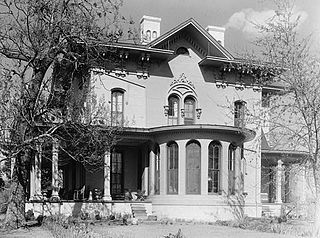
Camden is an Italian Villa-style house on the Rappahannock River just downriver of Port Royal, Virginia. Built 1857–1859, it is one of the nation's finest examples of an Italianate country house. It is located on the southeast bank of the Rappahannock River, about 0.5 miles (0.80 km) north of the intersection of Camden Road and United States Route 17. Camden was declared a National Historic Landmark in 1971 for its architecture.
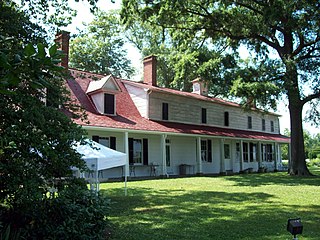
Sotterley Plantation is a historic landmark plantation house located at 44300 Sotterley Lane in Hollywood, St. Mary's County, Maryland, USA. It is a long 1+1⁄2-story, nine-bay frame building, covered with wide, beaded clapboard siding and wood shingle roof, overlooking the Patuxent River. Also on the property are a sawn-log slave quarters of c. 1830, an 18th-century brick warehouse, and an early-19th-century brick meat house. Farm buildings include an early-19th-century corn crib and an array of barns and work buildings from the early 20th century. Opened to the public in 1961, it was once the home of George Plater (1735–1792), the sixth Governor of Maryland, and Herbert L. Satterlee (1863–1947), a New York business lawyer and son-in-law of J.P. Morgan.

This is a list of the National Register of Historic Places listings in Caroline County, Virginia.
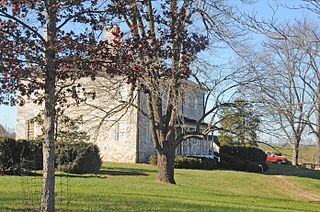
Mount Zion is a historic home located at Milldale, Warren County, Virginia. It was built in 1771–1772, and is a two-story, seven bay, fieldstone mansion. It has a hipped roof and four interior end chimneys. The front facade features windows in a widely spaced Palladian motif on the second story.

Caroline County Courthouse is a historic county courthouse located at Bowling Green, Caroline County, Virginia. It was built about 1830, and is a two-story, four bay wide, brick temple form building in the Jeffersonian Roman Revival style. The building is surrounded by a Tuscan entablature with a Tuscan pediment at either end. The front facade features an open arcade one-bay deep on the ground floor with six rounded arches.
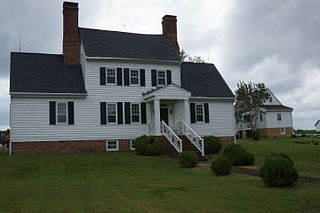
Green Falls, also known as Johnston's Tavern, Turner's Store, Wright's Corner (Fork), and Dolly Wright's Corner, is a historic home located at Bowling Green, Caroline County, Virginia. It is believed to have been built about 1710 and dating to the Colonial period. The frame dwelling consists of a two-story, three bay, single pile, central block flanked by one-story wings. It is considered by some historians to be the earliest surviving 18th century frame dwelling in Caroline County. The building housed a tavern in the 18th century, a store in the mid-19th century, and a post office from 1831 to 1859. It features massive brick exterior end chimneys. Also on the property is a contributing 18th century meat house, late-19th century carriage house, and early-20th century barn.
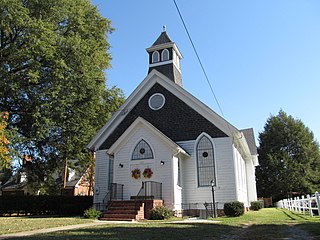
Bowling Green Historic District is a national historic district located at Bowling Green, Caroline County, Virginia. The district encompasses 169 contributing buildings, 1 contributing site, and 1 contributing structure in the historic core of Bowling Green. Notable properties include the Rains House (1737), A. B. Chandler, Sr. House, Bowling Green United Methodist Church, Shiloh Baptist Church (1895), Antioch Christian Church, Union Bank and Trust Company (1912), Bowling Green Baptist Church (1898), Caroline County Clerk's Office (1907), Bowling Green Town Hall, “Glasselton” (1846), and the site of the New Hope Tavern and Lawn Hotel. The Caroline County Courthouse and the “Old Mansion” are separately listed.
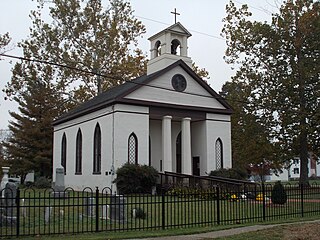
Port Royal Historic District is a national historic district located at Port Royal, Caroline County, Virginia. The district encompasses 35 contributing buildings in the historic core of the 18th century tobacco port of Port Royal. Notable buildings include the 18th-century Fox's Tavern, the mid-19th century Masonic Hall, the 18th-century frame mansion of the Brockenbrough family, the Hipkins-Carr House, the Gray House, and St. Peter's Episcopal Church. Townfield and Riverview are separately listed.

Mayfield Cottage is a historic plantation house located near the grounds of Central State Hospital near Petersburg, Dinwiddie County, Virginia. It was built about 1750, and is a 1+1⁄2-story brick Colonial era mansion. The building features a jerkin-head roof and distinctive interior woodwork. It is believed to be the oldest existing brick house in Dinwiddie County. From 1885, the property was used by the hospital for its headquarters and the house was part of the hospital complex until 1969. The house was moved from its original site about .5 miles (0.80 km) to the southeast of the present site in 1969.

Edgar A. Long Building is a historic building located on the campus of the former Christiansburg Industrial Institute at Christiansburg, Montgomery County, Virginia. It was built in 1927, and is a 2 1/2-story, rectangular brick building in the Colonial Revival style The front facade features an advanced central pavilion with a brick pedimented gable containing a half circular garret vent. It has a classical cornice and a gabled deck on a hipped roof. It was constructed following the move from the separately listed Old Christiansburg Industrial Institute.
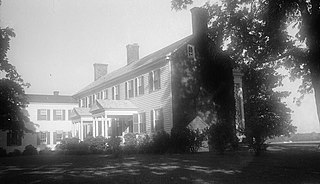
Vaucluse is a historic plantation house located near Bridgetown, Northampton County, Virginia. It is a complex, two-story, ell-shaped brick and frame structure with a gable roof. Attached to the house is a 1+1⁄2-story quarter kitchen with brick ends. The brickended section of the house was built about 1784, with the addition to the house added in 1829. The annex connecting the house with the old kitchen was probably added in 1889. It was the home of Secretary of State Abel P. Upshur (1790-1844) who died in the USS Princeton disaster of 1844. His brother U.S. Navy Commander George P. Upshur (1799-1852), owned nearby Caserta from 1836 to 1847.
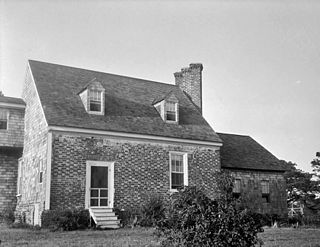
Winona is a historic home located near Bridgetown, Northampton County, Virginia. It dates to about 1681, and is a small, 1+1⁄2-story, brick structure with a gable roof. It measures 32 feet, 6 inches, by 27 feet 6 inches. It features an exterior end chimney with three free-standing stacks set diagonally on the base.
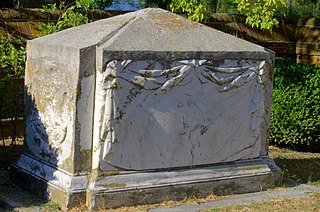
Custis Tombs, also known as Custis cemetery at Arlington, is a historic family burial ground located near Cheapside, Northampton County, Virginia. It consists of two tombs surrounded by a poured concrete platform raised a few inches above ground level. It includes the grave of John Custis, Major General and member of the Council for Virginia and progenitor of the Custis family in America. The other tomb is the box-like marble tomb of John Custis IV (1678-1749) with its pyramidal top and drapery carvings on the long sides. The tombs were associated with Arlington mansion and located west of the separately listed Arlington Archeological Site.

























